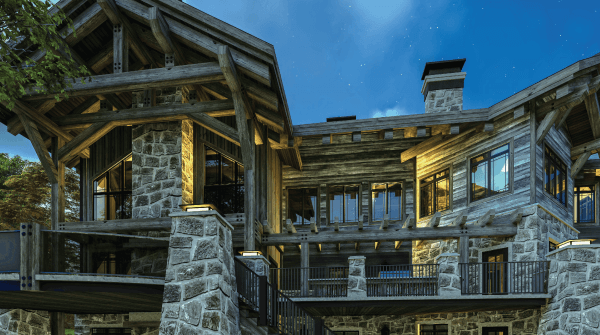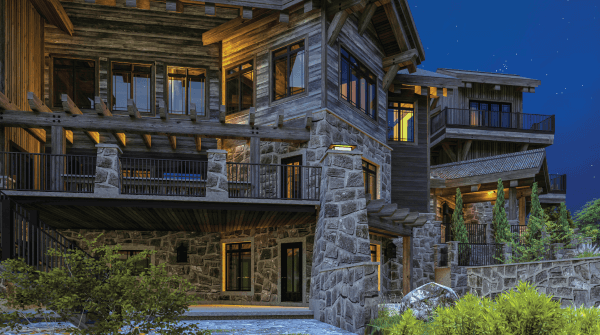With roughly $750 million in construction projects under his belt and over 26 years within the AEC industry, Duane Addy has built a career on quality design and rendering production—a career that is only as successful as the performance his software and hardware. As many organizations look to send project renderings to the cloud, Duane Addy has stood firm and put his trust in BOXX— a decision he can back with benchmarks.
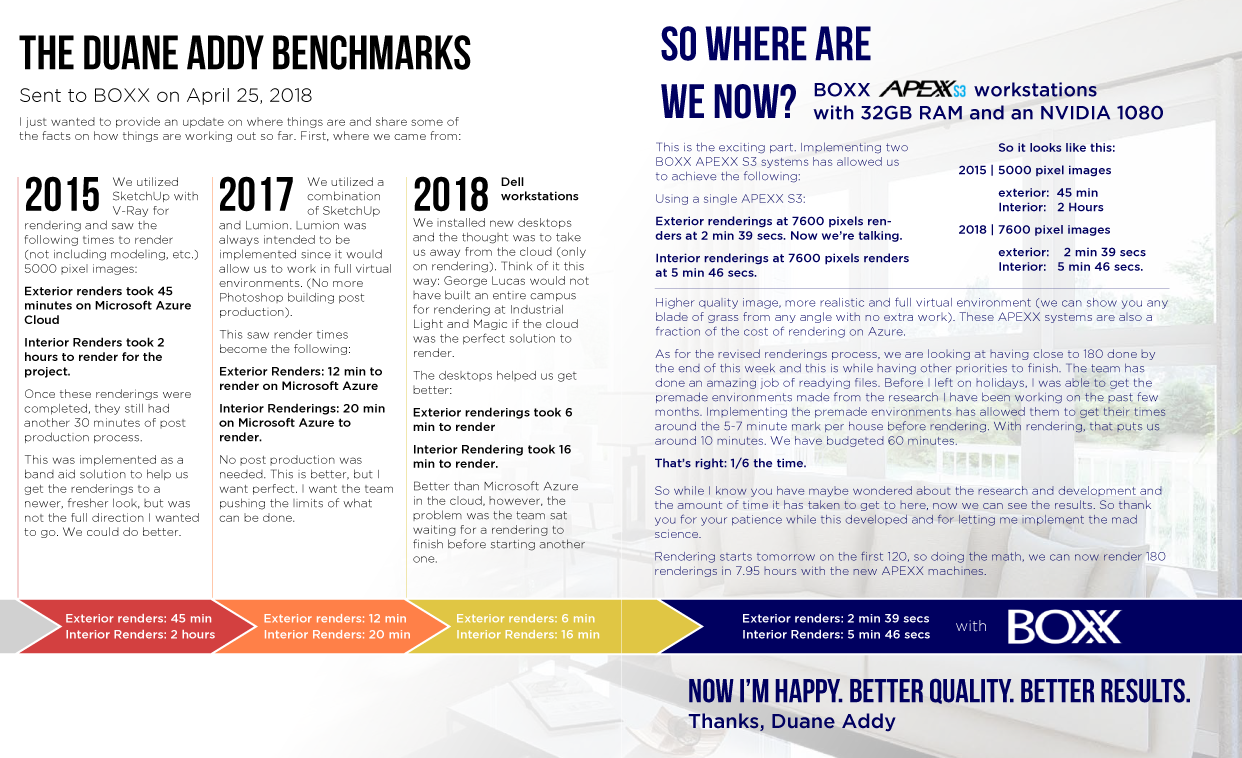
That was one thing that I was always wanting throughout the years. Many companies are going the route of online cloud-based systems and while I understand and agree for the most part in doing this, when it comes to cloud based rendering I haven’t totally bought into it yet. Many times, in business we must make calculated decisions quickly and in order to do that effectively, we need to have all the facts. Most often, these facts are derived from the continual testing of benchmarks and proving which rendering process is better. Again, I completely understand the reasons as to why cloud-based IT systems are great (enhancing storage, redundancy, and accessibility from anywhere), but I just am not there yet with rendering. Based on my experience, unless you’ve really done rendering, it’s hard to understand it and why a physical machine just works better. Most people would think it’s just computing power, but there’s a whole science to it. For the last couple of years, there’s been a challenge between designers, modelers, and IT departments on pushing rendering to the cloud and I think that many of them, especially those that I work with, understand now. That’s probably because I can be a bit of a pitbull with a bone (laughs)!
Based on the times I have now versus a cloud test, we have helped everyone to understand. Joking around one day I said to an IT Director, “I’ll tell you what, when George Lucas decides to switch Industrial Light & Magic over to a cloud-based system or when Digital Domain does it, I will agree and submit to adding mine to the cloud, but considering they just built new campuses and have run hundreds of thousands of miles of network cable to all the processors and the render farm, I don’t think that will happen for quite some time.” So, George if you’re reading this please, please take your time.
Well through many years of trial and error I’ve done rendering and animation with some machines bought, others built, and tons of software, and it was from those years of “error” I knew what I needed to do and what I didn’t, so it was more a point of proving why people needed to simply trust my decisions.
I graduated from Fanshawe College in London Ontario. They have a four-year architectural technology program where we learned the architecture and design side of things, but also the building science and technological side. I’ve known since I was 12 years old that I wanted to be in this business, so I wanted to learn anything and everything that I possibly could. I started as a framer when I was 17 or 18 years old and then tried taking every job I could all the way through college working for pre-engineered construction, steel detailing and design, and working my way up to project management. I’m coming up on 1700 projects that I’ve worked on myself and close to $750 million total in construction and design. It’s been a 26-year career with everything from 100 square foot additions and 18,000 square foot custom homes, to high rises.
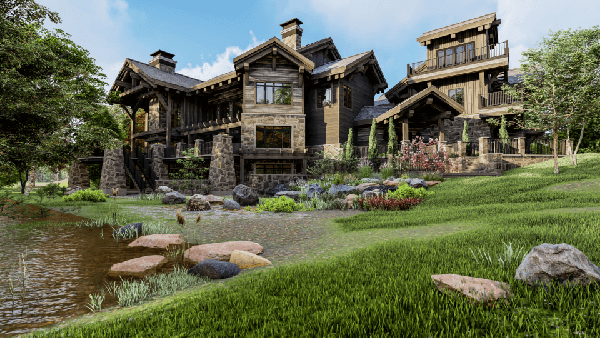
When I got out of school I wanted to get a new car. I was driving an old beater, so I test drove a new model which immediately made me think if I’m paying $25-30,000 for a new car and I can first test drive this vehicle, why would I ask clients to trust me on the single biggest investment of their lives but, yet they can’t test drive it. That was in 1997. That’s when I really got into the rendering side of things. I wanted to make it a point of every job, I wanted to know anything and everything about 3D. I wanted to be able to showcase it to customers first, then the builders and trades, so that’s where it started. Over the years, it’s been numerous software products, trying to get rendering times down. Today, with all of my projects, I try to build-in full interactive virtual construction models that I can not only pull quantifiable data and drawings from, but models that showcase realistic renderings as well. With regard to renderings, I focus on realism as much as possible. It’s really fun as I work on projects from small $50,000 construction budgets to $320 million projects, as well as everything in between.
I have eleven designers with whom I work hand in hand on a variety of projects. In a very short amount of time, over 200 renderings for a $320 million project were completed, along with several other facets of the project: one batch of 155 single family renderings, a second batch of 650 single family renderings, a 174 unit townhome project, all on top of developing a new, innovative way of designing and modeling that I am just now implementing into my overall process. It’s something I have been working on the last eight years and it’s finally at the point where I am using it daily.
Typically, I’ll come up with the concept, a 2D floor plan first, then an initial 3D concept model. From there, depending on what task is required (rendering, interactive virtual construction model, quantity take off, etc.) I will begin modelling a more detailed model. From that model, I can spin off the initial set of drawings and/or renderings, fulfill quantity takeoffs, and more. The project then goes to the next step in media delivery and fulfillment. This is where it either becomes an interactive experience or static media such as wall renderings for sales centers, brochures, and the like. I always do exterior renders, but not every job gets interiors done.
Yes. On the larger multifamily projects, I’ll do multiple renderings for the interiors. Up until now, only about 40% of the single family projects go with the interior, unless it is a large-scale builder and they want to showcase new models. Occasionally, we rely on an associate of mine, John Brock, who has trained and worked within my main software SketchUp as long as I have.
John and I have always said we’re brothers from different mothers. We just share the same philosophy that it didn’t make sense to not know what you were building. John is a builder, and over the last eight years, he and I have been developing a system by which he, as a builder, and I, as a designer, look at the construction process from two different vantage points. With this system, we can actually know anything and everything about a project. Once we implement it, it will allow us to actually produce interior renderings for every project. Up until this point, most clients and companies I have worked with or worked for have been primarily using AutoCAD with some Autodesk Revit. John and I made the switch over to SketchUp about eight years ago which allows us to do full construction drawings, the interactive virtual construction model (IVCM), the renderings, everything tied to that one house. Right now, based on our system, we’ve been able to substantially lower development times while decreasing cost overages on site by as much as 40%. Where it would typically take two weeks to do an entire project where you’re just getting your AutoCAD drawings and an exterior rendering, we can do a full IVCM model, including all framing, quantity estimates, renderings inside and out, a full set of construction drawings, interactive pieces, all in just over three days. We’re cutting down from two weeks to three days! With everything I’m trying to implement, I’m always looking at the time side of things. Rendering times have to come down and development times have to come down, so that’s what I’m always pushing for.
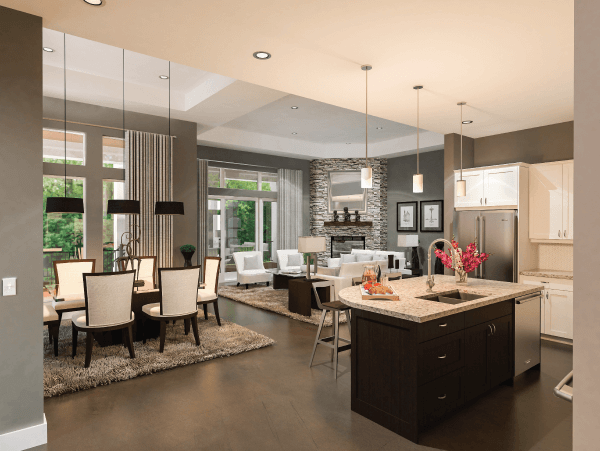
I just made the switch to Lumion about a year ago am really loving it. Back when I first started working with SketchUp, I learned from them that the beauty of it is that it can be as little or as much as you want it to be. If you want more, you can build custom plug-ins, but it’s intuitive and scaled back on purpose. I think Lumion has done a similar job where you’re so used to everything almost being over complicated that they’ve scaled things back and made it very simple. Once you determine how you want your lighting rig to be for doing interiors, it becomes something you can save as an effects stack and then you can apply it to each interior you’re doing. I look at how our rooms are laid out, for example. If I’ve come up with a lighting rig for one of the houses that has two large windows across the back, French doors, or some other feature, that’s in there. I can then apply that same lighting stack on very similar designs and cut down the workflow time.
I look at things like that, the shape of the building based on how I’ve done that lighting and that’s something Lumion has become very good at—the ability to save those FX stacks. The same with material stacks. You can set up all your materials whether it be stainless steel, granite, cabinets, flooring, and you can have all that and simply export it out as a material stack and then you bring it into another scene. It’s essentially doing a lot of the work for you. I love working with Lumion, the interactivity, and my team loves being able to fly around inside of it.
The switch over is the biggest challenge right now because you’re asking people to change and sometimes people are open to change while other times they’ve been with a company for 20 years and satisfied with the way they’ve always done it. I’m a firm believer that good design always evolves as much as history repeats itself. You’re never going to do something 100% fully creative that’s never been done. If you put columns in the front, the Romans already did it. If you crumpled the side of the elevation wall ---Frank Geary already did it. Good design evolves and better execution evolves quicker. That’s where we always want to be pushing the limits of what we do and how we do that and always looking at new products and new ways. When you produce 650+ single family renderings in 2.5 months, you don’t have a whole lot of time. You need to get in, get it done right, and move on to the next one. That’s what we have to be cognizant of. That’s why we always have to be evolving. The hardest part is getting people into that mindset that we are going to be changing and implementing more VR strategies. There are a lot of really cool things out there that I’d really like to see adopted, but we have to do it one step at a time and make sure we do it right.
In 2010, I was with a company and we were frustrated with our rendering performance. We would build our own rendering machines because we thought, “We can build these for a thousand bucks apiece and have twenty of them.” We didn’t know anything about rendering, so at that point, it was a lot of trial and error as I said earlier, money spent, and not getting the numbers we wanted. We went looking on the internet and came across BOXX, the renderBOXX product, and kept reading up on it—specs, customer stories, anything that we could find, because we were a very small company where every dollar counted. It was a serious investment. We purchased five renderBOXX modules and it dramatically changed are lives—like night and day. The best part was they were robust. They could take a beating and just smile back at you.
Fast forward to today - Just prior to implementing Lumion, we tested the online cloud system using Microsoft Azure Cloud Service as well as on local machines. Even though we were working in the cloud, I kept thinking about my previous success with the renderBOXX systems and how it could be the basis for more major success.
 So you’re switching to Lumion, a GPU-based renderer, which necessitated a hardware switch. You’ve tested online cloud systems and from that you concluded that new BOXX APEXX S3 workstations for rendering would be the better way to go. Tell me about that and the creation of the benchmarks.
So you’re switching to Lumion, a GPU-based renderer, which necessitated a hardware switch. You’ve tested online cloud systems and from that you concluded that new BOXX APEXX S3 workstations for rendering would be the better way to go. Tell me about that and the creation of the benchmarks.
It’s probably not the way I would suggest anyone else do it, but there was a lot of frustration leading up to the benchmarks because I’m responsible and overseeing hundreds of renderings at any given time. I can’t be spending seven months of the year on those. I need them to be out quickly. IT consultants and managers want to move toward where there are not a lot of physical machines on site because that means replacing machines every few years, i.e., the product life cycle and I totally get it.
One of the things I tried to explain was you cannot kill a BOXX. That’s the thing. An eight year-old BOXX will still run. It’s a different kind of system. There is a secret sauce one that no other machine possesses. I acknowledged that there are a lot of different ways of doing things, I just needed a resolve to move forward with the tasks. As I said earlier, if someone has never done a rendering, they cannot understand completely what it takes and sometimes it can lead to several voices offering opinions. In the end, the one who has the most experience in running the systems and is responsible for their performance has to be left to do what is best. It was on one of those days I just said “Everyone, you just have to trust me.” It was at that point I was able to get the first two BOXX workstations internally and the render times speak for themselves. They dramatically reduced render times, but there was still that nagging question from IT consultants where they felt building a system with the same specs would be cheaper. Having the history of both building my own systems and using BOXX, I always caution when someone says something like that because I do know how it will end. You can use the same specs, but you’re never going to get the render times that you do with the BOXX machines because BOXX, as I said, has the secret sauce. It’s something developed in the pipeline that uses every facet of the machine and produces better results. Build your own all day, but you’ll never get the times that you do out of a BOXX. It’s like going to Hardees and asking for a Big Mac. It will be a burger with lettuce and cheese, but it won’t be a Big Mac.
Now we have these machines, so how much more do we implement in terms of team members doing renders? How much work do we see per year and how many BOXX systems do I need to order for the next year or two? That’s where I am now. The trust is there. Everyone involved sees the numbers, sees the results. Put everyone else on the cloud, but leave rendering alone (laughs).
We had 180 renderings due in just over two weeks. I had gone away on holidays and while I was away, my team had taken all the models and brought them into Lumion. Overall, it took them about a week. These were ready to render, so about the time I got back, we had just received the APEXX S3 systems so we put them all together. We were rendering at 7600 pixels and did all 180 in less than eight hours, finishing in just over a week in total prep and total rendering time. We cut it down by half in terms of the deadline. It’s almost like a security blanket. You now have that trust in the machine. Now it’s okay if a client wants to see the interior of a scene I’ve been working on. If they come into my office and say they need it this afternoon for design meeting I know I can work right up until the meeting because it will take an interior rendering 5 minutes and 42 seconds at 7600 pixels or an exterior at 7600 pixels in two minutes, 34 seconds. I know I can render that out and throw it into Adobe Lightroom to do a few adjustments.I essentially need ten minutes to render and tweak it, so I can work right up to close deadlines.
BOXX has had my back for the last eight years, so the trust is there. That’s why it was easy for me to stand up against IT consultants and managers and say with confidence “We need to look at BOXX,” because there is that experience and BOXX has never let me down. The quality is second to none. I also know BOXX has awesome technical support, but happily, I’ve never had to use them.
I’m starting to get into much bigger projects with a lot more interactive and media work in addition to the architectural design. The team I’m involved with — project managers, construction managers, and estimators are always the best at what they do and exceptional in every aspect. They’ve met every challenge, even if it’s something we’ve never done before. From the design side, I’m always looking to push those limits. How can we make things more interactive? How can we have more realistic renderings? How can we deliver something faster without substituting quality? So BOXX is going to be a big part of that because if I had my way, I’d have all of my workstations be BOXX workstations. When you get into the larger panoramas, the one thing I don’t want is anyone to think there is a quality issue, so I always render to the higher resolution so we can see crispness and detail, especially when adjusting and tweaking inside of Lightroom and Photoshop. You have to have that strong base image and you have to have that powerhouse hardware behind you in order to produce those images.
With the number of houses that I have rendered, and with being on track to do more than last year, along with larger scale projects, plus new townhomes and street towns, there is always going to be a large number I must juggle. So much will come down to efficiencies and speed, timing, and scheduling, but we need to make sure that the best equipment is always there to produce those times. The one thing we don’t have to worry about is BOXX. These workstations have been phenomenal and (BOXX performance specialists) Rich Petit and Matt Gubitz have been exceptional guys to work with. I’m look forward to 10 or 20 more years of working with BOXX. They have the vehicle to take me where I want to go.
